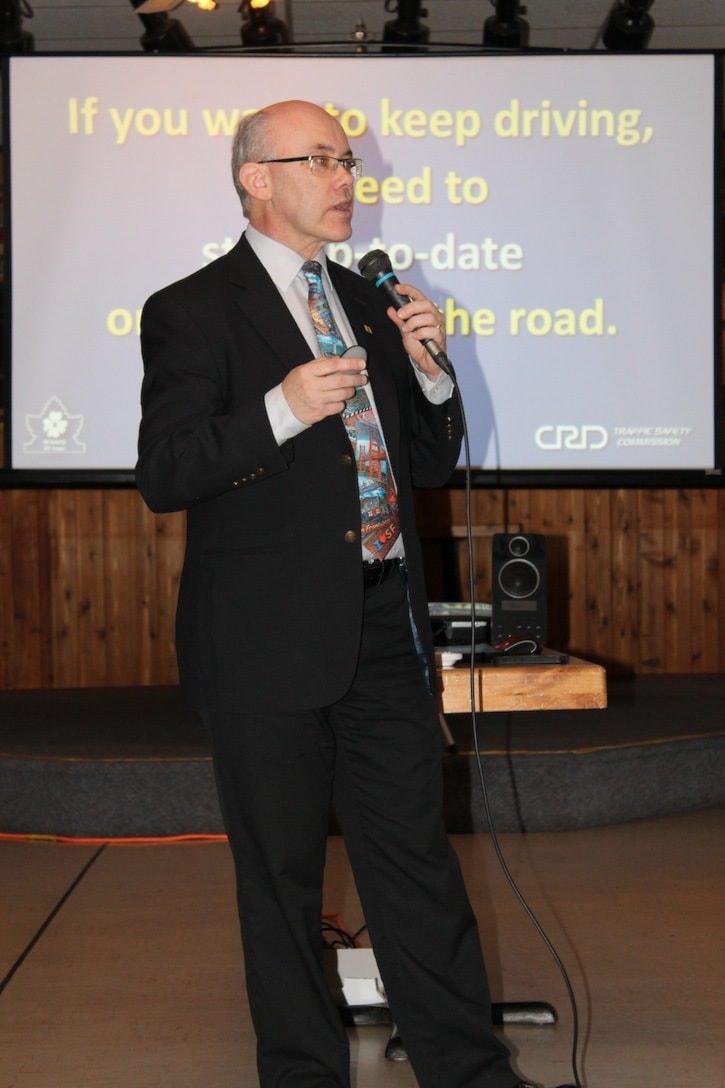What kind of skills do you think an operator should have if they want to continuously navigate a 4,500 pound chunk of metal through your community?And if it’s been 60 (or 50 or 40) years since this operator was last certified, should they at some point in time be re-certified?
The chunk of metal in question is a standard four-passenger sedan. Generally speaking, an individual can go up to 64 years without being re-certified.
For the most part, it works out okay, but sometimes, it does not. Like when 81-year-old Shirley Zerbin confused her foot controls and drove into a group of taxi-drivers, killing Ramesh Sharma.
In March, Alan Perry, Special Projects Co-ordinator, CRD Traffic Safety Commission, gave a very informative presentation to the B.C. Pensioners’ and Seniors’ Organization at Sooke’s Legion.
At the heart of his presentation was the DriveABLE program, which is one of two screening tools used by the Office of the Superintendent of Motor Vehicles (OSMV) to ensure drivers are safe to operate vehicles.
One is age related. The other is related to cognitive ability.
The age-related assessment is the Driver Medical Examination Report (DMER). When a licensed driver turns 80 years old, that person is required to to complete a DMER through their physician and resubmitted every two years thereafter.
The cognitive-related assessment is the DriveABLE Cognitive Assessment Tool. DriveABLE is not age-related. People requested to take the assessment have been referred to the OSMV by a medical practitioner.
Stephanie Melvin, Deputy Superintendent of Motor Vehicles, said that when a physician is examining their patient and sees some kind of cognitive decline, “then we’ll take that information and we’ll follow-up.”
Step one: The computer test
The assessment itself begins with an in-office computer test, designed for people who have no knowledge of computers.
The computer assessment measures key variables critical to safe driving: memory, attention span, reaction time, spatial judgement and decision making.
Recognizing that exam anxiety can influence the outcome of the exam, OSMV has practice tests.
Step two: The road test
Next comes a special on-road assessment where you ride with an examiner.
Depending on the outcome of the in-office test, everyone -- even if you fail the in-office assessment -- has an opportunity to do a special on-road assessment. This one is focussing on looking for those kind of errors that people make when their level of cognitive ability has declined to an unsafe level.
Skills deterioration not evident in the in-office test gets picked up in this second test. “Quite often it will be not realizing that you are drifting into the other lane, not being able to either speed up or slow down to the appropriate levels. There’s lots of ‘tells’ that show that your cognitive abilities have declined.”
The core philosophy behind the program is keeping safe drivers on the road. “Healthy drivers are safe drivers,” Melvin concludes.
The DriveABLE test, if requested by OSMV, carries no charge for the driver.
Retaining control
Once an individual’s cognitive abilities begin to erode, it becomes increasingly difficult to convince a driver to relinquish their driver’s license.
According to Perry, we tend to outlive our ability to drive by about 10 years.
Retaining autonomy is a matter of control. “Plan ahead and have some control over it,” recommends Melvin. If you take control and set up options like getting groceries delivered, taking the bus, and commuting with others, then, when it comes time for you to surrender your license, you have your options already in place.
The DriveABLE program is administered through OSMV. Residents of Sooke who are requested to do the DriveABLE exam can go through Driver Fitness in Langford that administered both the screen test and the road test. They are at #204-3340 Goldstream Ave.
